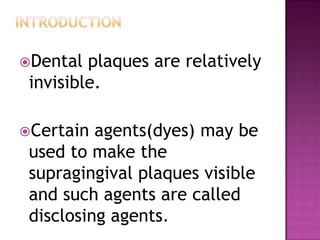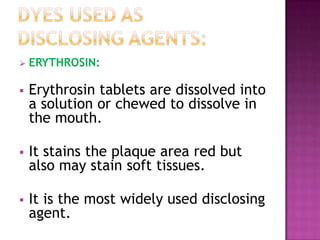Disclosing agents
- 2. ïDental plaques are relatively invisible. ïCertain agents(dyes) may be used to make the supragingival plaques visible and such agents are called disclosing agents.
- 3. ï ERYTHROSIN: ï§ Erythrosin tablets are dissolved into a solution or chewed to dissolve in the mouth. ï§ It stains the plaque area red but also may stain soft tissues. ï§ It is the most widely used disclosing agent.
- 4. ï FLUORESCEIN DYE: ï§ On application,fluorescein dye stains the plaque yellow. ï§ It does not stain the soft tissues. ï§ But special light is required to see the stained plaque. ï§ It is more expensive.
- 5. ïT°Â°ŋ TONE DYES: ï§ A solution containing a combination of two dyes is used. ï§ Mature plaques are stained blue,while new plaques are stained red.
- 6. ï ADVANTAGES- ïķ Theyhelp to differentiate mature and immature plaques. ïķ They do not stain the gingival tissues.
- 7. ï IODINE CONTAINING SOLUTIONS: ï§ They have been used as disclosing agents but have the disadvantage of causing a high incidence of allergic reactions. ï§ Also have unacceptable taste.,hence not preferred.
- 8. To stain the plaque,solutions of disclosing agents may be used as follows. ïą Painting the teeth with a cotton swab. ïą Rinsing the mouth. ïą Astablets or wafers to be chewed dissolving it in the saliva.The mouth should then be rinsed with water.
- 9. ï Genetically determined abnormality to a chemical. ï Typeof reaction is restricted to individuals with a particular genotype. ï Certainbizarre drug effects due to peculiarities of an individual are included among idisyncratic reactions.
- 10. ï Barbituratescause excitement and mental confusion in some individuals. ï Quinine/quinidine cause cramps,diarrhoea,purpura,asthma and vascular collapse in some patients. ï Chloramphenicol produces nondose-related serious aplastic anaemia in rare individuals.
- 11. ï Appearance of characteristic toxic effects of a drug in an individual at therapeutic doses. ï Converseof tolerance and indicates a low threshold of the individual to the action of drug. ï These are individuals who fall on the extreme left side of Gaussian frequency distribution curve for sensitivity to the drug.
- 12. ïA single doe of triflupromazine induces muscular dystonias in some individuals,specially children. ï Onlyfew doses of crabamazepine may cause ataxia in some people. ï One tablet of chloroquine may cause vomiting and abdominal pain in occasional patient.












